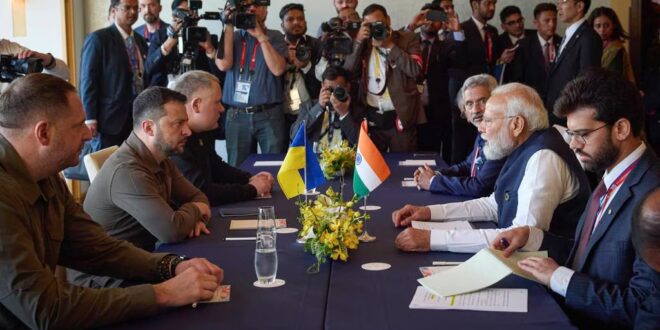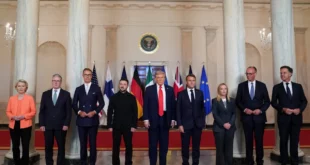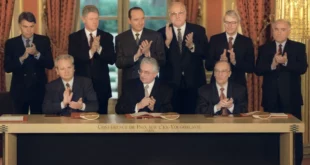Bakhmut, the midsize Ukrainian city that used to have a population of 80,000, is now reportedly in Russian hands after a bloody nine-month military operation that turned the area into a wasteland. But regardless of who controls Bakhmut, the war will go on for the foreseeable future — the U.S. intelligence community assesses the fighting will progress well into 2024.
Ukrainian President Volodymyr Zelenskyy, of course, knows all of this and is preparing for a long conflict. The comic-turned-wartime commander in chief has devoted the last week overseas, traveling to several countries to ensure Kyiv’s backers in the West remain committed to providing the military and economic support his army needs for the war.
His tour through Europe last week was a resounding success on that front. After visiting Germany, France and the U.K., Zelenskyy came away with concrete packages of additional military aid from each. French President Emmanuel Macron promised to supply dozens of light tanks and armored vehicles. The Germans approved $3 billion worth of infantry fighting vehicles, tanks and air defense systems. U.K. Prime Minister Rishi Sunak greenlit the transfer of missiles that have a range of 150 miles, putting Russia’s supply lines at greater risk.
Zelenskyy’s guest appearance at the G-7 Hiroshima Summit in Japan over the weekend was the cherry on the cake. The world’s wealthiest democracies pledged to enhance the sanctions regime against Russia, slapped new import bans on Russian products like diamonds and endorsed Zelenskyy’s war aims in writing. President Joe Biden, meanwhile, reversed himself on the supply of F-16 fighter jets to the Ukrainian air force. European countries with F-16s will now be permitted to send those aircraft to Kyiv.
The G-7 summit wasn’t all sweets and flowers for the Ukrainian leader, however. Zelenskyy’s primary mission was to squeeze the West for more military commitments. In that respect, he clearly succeeded. But he failed in trying to bring crucial leaders in the global South, like Indian Prime Minister Narendra Modi and Brazilian President Luiz Inácio Lula da Silva, into his corner.
While Zelenskyy had some positive interactions with Modi, the Ukrainian president left the forum without much to show for it. The most Modi could offer was India’s continued efforts to work toward peace. Lula didn’t even sit down with Zelenskyy and in fact seemed to take efforts to avoid him.
It’s difficult to see what Zelenskyy could have done to change their minds. The lack of results is less about the Ukrainian president’s ability to glad-hand his peers than it is about the existence of some very rigid differences on the war between Ukraine and its Western supporters on the one hand and the developing world on the other.
Those differences are too numerous to count. The West, with the U.S. often in the lead, has tended to view the war in Ukraine as the quintessential example of what a geopolitical good vs. evil clash looks like (there is no question Russian forces have engaged in evil acts; look no further than Bucha). Anything short of unlimited, unquestioned military support to Ukraine is viewed as insufficient at best and immoral at worst. You’re either a part of the solution or you’re part of the problem. As U.S. Secretary of State Antony Blinken said in February, “There is no neutral position when it comes to a war of aggression. There is no balance.”
But this isn’t the paradigm through which much of the world outside the U.S. and NATO sees the conflict. For nations like India, South Africa, Brazil, Turkey and Indonesia, the war itself is the personification of evil — not any one party.
Ukraine and Russia are both contributing to the bloodshed and destruction and both therefore have a responsibility to work their way toward ending it. Brazil’s Lula has been more directly outspoken about this point than most, going so far as to blame Zelenskyy and Russian President Vladimir Putin equally for the devastation wreaked on Ukraine. The West cringes at this type of language; the White House even accused Lula in April of recycling Russian and Chinese propaganda. But the view is nevertheless out there, and it’s one that resonates outside Western capitals.
The West and the global South also don’t share similar objectives, to Zelenskyy’s frustration. While both theoretically want the war to end, the two disagree on how and even when to end it. Washington and its NATO allies are arming Ukraine to hold off further Russian offensives and improve the prospects of a successful Ukrainian counteroffensive, which would strengthen Kyiv’s position in the event negotiations with Moscow become plausible. The U.S., France and Germany have also been quite clear that only Ukraine can decide when (or even if) end-of-war talks with Russia occur.
This is not India, South Africa or Brazil’s position. All three countries want to cease hostilities immediately — the sooner, the better. The top priority isn’t defeating Russia but establishing a cease-fire, using the calm generated by the pause in the fighting to begin negotiations on a settlement and mitigating the economic impacts (like food supply shortages) associated with the war.
All three countries have either spoken about the need for peace talks or are in the process of formulating their own peace proposals — a coalition of six African countries will soon visit Zelenskyy and Putin to discuss possible confidence-building measures like more prisoner exchanges and a broadening of the Turkish-facilitated deal unlocking grain and fertilizer exports from Ukraine and Russia.
In short, there were wide gaps in the room when Zelenskyy took his seat at the conference table in Hiroshima. Where you stand often determines where you sit. And to Ukraine’s disappointment, there isn’t much evidence this rule of thumb will change anytime soon.
 Eurasia Press & News
Eurasia Press & News




